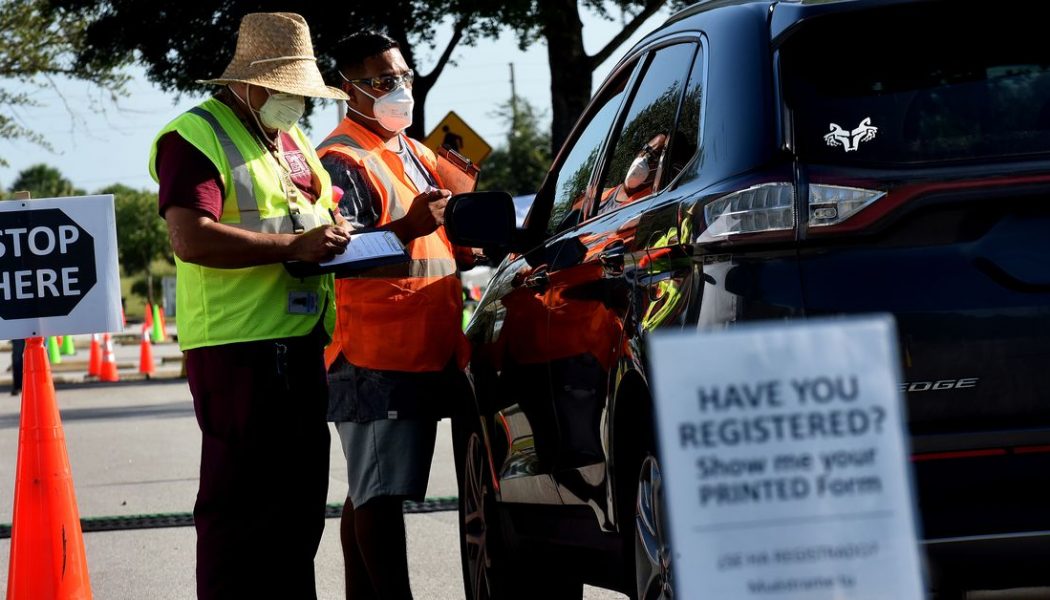
When someone gets a COVID-19 test, the result does one thing: tells that person if they have the coronavirus in their body. Some researchers, though, are trying to get tests to do more — and reframing the goal of testing as a result. Instead of simply finding people who are infected with the virus, they’d prefer to focus on finding people who are infectious and at risk of spreading it to other people.
The proposal offers one possible way to get the pandemic under control in the US. It would allow for a more targeted approach to isolation and quarantine and help give people a better understanding of when they’re most at risk to others.
It would be a big change in how we think about testing. Clinicians have never used tests for respiratory infections like COVID-19 to determine if someone is infectious, says Matt Binnicker, director of clinical virology at the Mayo Clinic in Minnesota. The concept is interesting and could be useful, he says. “But there are a lot of potential pitfalls.”
Let’s start with how we think about tests now. When researchers develop tests for viruses, they typically aim to make them as accurate as possible. The Food and Drug Administration grades tests based on how well they can catch everyone who has an infection and how often they rule out everyone who does not. Typically, the very best tests are the ones that can catch every single person who has even the slightest bit of virus in their system.
The trouble with the coronavirus, though, is that it sticks around. Tiny amounts of the virus’s genetic material could stay in someone’s nose or throat even after they’re better. That could cause them to keep testing positive for the virus. That’s one reason experts think there’s a downside to highly sensitive tests. These tests often catch people who probably don’t need to be in isolation because they’ve already gone through the course of the illness.
The alternative is using less sensitive tests. It’s an idea that’s been promoted by experts like Michael Mina, an epidemiologist at Harvard School of Public Health, and covered in articles in The New York Times and The Atlantic. These tests wouldn’t be as likely to come back positive when there were only a few bits of virus in a patient sample. Instead, they’d be set off when people have lots of virus floating around in their body — a sign that they’re in the throes of an active infection, even if they’re not showing symptoms. That’s preferable, some experts say, because those are the people public health officials are most worried about.
There are a few ways to do that. One would be to rely more on tests that detect the small proteins on the surface of the coronavirus. These antigen tests are fast but tend to be less accurate. We could also change how we interpret information from the more-accurate PCR tests that are commonly used. PCR tests look for coronavirus genes. They make copies of the virus in a sample, amplifying it over and over until it’s detectable. The more copies it takes to detect the virus, the lower the amount that was there to begin with. To make the tests likely to flag samples with negligible virus, clinicians could lower the cutoff point for the number of copies they let a sample run through.
But these “test people with less sensitive tests” strategies are based on an assumption. The idea is that people who have lots of virus are the most contagious, and people who have low levels of virus are less contagious. It’s not an unreasonable assumption, says Mark Slifka, a professor at Oregon Health and Science University studying viral immunology. It makes intuitive sense: someone with more virus is more likely to exhale viral-laden droplets than someone with less virus.
There’s some indirect evidence to back this idea up. Lab experiments have shown that it’s easier to grow coronavirus from patient samples with a high viral load than from samples with a low viral load. This is a sign that the virus in the higher-count sample is actually infectious (not just dead leftovers). It’s also hard to find infectious virus in samples taken around 10 days after symptoms start — and that’s the window of time contact tracing shows that people are most likely to pass the virus to a close contact, Slifka says.
But there’s still not enough data to fully explain the relationship between viral levels and infectiousness. Someone with a lower level of virus might have a lower probability of infecting others, but it doesn’t mean that they can’t. “I don’t think that we have enough data to conclude that people are only infectious when they’ve got really high amounts of virus,” Binnicker says. “I’m pretty comfortable saying that a person is more infectious.”
That’s because levels of virus aren’t the only thing that can contribute to infectiousness. Someone who has lots of virus but doesn’t have symptoms might be less likely to infect another person than someone with lower levels of virus who coughs every so often. “It’s not telling the full story,” says Jen Heemstra, an associate professor of chemistry at Emory University.
The levels of virus measured by a test are also sometimes wrong. Someone might have higher levels of the virus than what appears on the swab. It depends on how thoroughly the test is taken. If a tester only lightly brushes a swab against the throat, they might not pick up much virus — even if the person actually has high levels. A low-sensitivity test might not flag them, even though they have enough virus that it should. “We’ve all had strep tests where it just kind of touches the throat, and we’ve had others with nurses who really scrape it — that influences the test,” Binnicker says.
Making tests less sensitive also runs the risk of missing people who are early on in their infection. Analyses of COVID-19 patients show that the amount of virus starts low and rises quickly at the start of illness before falling back down. A test doesn’t distinguish between someone who has low levels of virus because they’re recovering and someone who has low levels because they just got sick. Someone who just got sick is going to have high levels of virus (and potentially become more contagious) very soon.
Take a hypothetical person named Bob, who comes into contact with someone who has COVID-19, Slifka says. When Bob gets tested, he has a low level of virus. “He could be on the downward slope, where he’s already cleared it, and would continue to be less likely to transmit,” Slifka says. “Or it could be the opposite, where he has a viral load that’s low and then goes up.”
It’s a fixable problem, but it requires getting more information from Bob and sending Bob to get more tests. That way, if he doesn’t get flagged in a test on Monday, he’d be tested again on Wednesday to see if his viral levels rose. “If you can test people frequently enough, and then couple that with a lot of monitoring and data collection, then you can start to really piece together,” Heemstra says.
Implementing this strategy would mean dramatically scaling up the amount of testing done in the US each day and making sure people don’t wait multiple days to get a result. That takes increased manufacturing, better distribution, and political will — at a time when the Trump administration seems determined to limit testing. The administration pushed the Centers for Disease Control and Prevention to change its guidelines around when people without symptoms should be tested. Admiral Brett Giroir, the US testing leader, said this week that a world where all Americans could get fast, regular, and cheap COVID-19 tests was an unrealistic “utopian world.”
Logistical problems aside, Binnicker says he’d like to see more evidence that low-sensitivity tests could actually separate infected people from infectious people and help control the spread of COVID-19. That might mean testing a few hundred people multiple times a week with a low-sensitivity test and watching to see if repeated testing could keep the virus from spreading.
“It’s always useful to talk about innovative ideas,” he says. “I think the problem was the proposition was put out there without much in the way of supportive data to show that it could work.”










